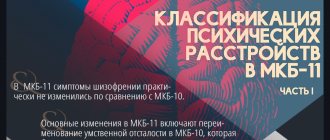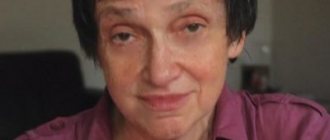Authors: Mukhin K.Yu., Petrukhin A.S.
Part 1:
- Introduction
- Definition, classification of epilepsy
- Idiopathic generalized epilepsy
- Pediatric absence epilepsy.
- Juvenile absence epilepsy.
- Epilepsy with isolated generalized seizures.
- Juvenile myoclonic epilepsy
- Idiopathic partial epilepsy
- Rolandic
- Idiopathic partial epilepsy with occipital paroxysms.
Part 2:
- Cryptogenic generalized epilepsy
- Lennox-Gastaut syndrome.
- Epilepsy with myoclonic-astatic seizures.
- Epilepsy with myoclonic absence seizures
- Symptomatic partial epilepsy
- Symptomatic temporal lobe epilepsy
- Symptomatic frontal lobe epilepsy
- General principles of treatment of epilepsy
Causes of temporal lobe epilepsy
A number of factors can trigger the development of this disease. In some cases, the epileptogenic discharge does not occur in the temporal lobe of the brain itself, but comes there from other areas of the main organ of the central nervous system.
All reasons can be divided into two groups:
- Perinatal (prematurity, fetal hypoxia, etc.).
- Postnatal (allergies, alcohol addiction, poor circulation, vitamin deficiency, metabolic disorders, severe intoxication of the body).
Reasons determining the occurrence and development of temporal lobe epilepsy:
- birth injuries;
- fetal hypoxia;
- intrauterine infection (syphilis, rubella, etc.);
- asphyxia of a newborn child;
- traumatic brain injuries;
- neuroinfections (purulent meningitis, encephalitis, post-vaccination encephalomyelitis, neurosyphilis);
- tumor of the temporal lobe of the brain;
- vascular malformations;
- hemorrhagic and ischemic stroke;
- cerebral infarction;
- tuberous sclerosis;
- intracerebral hematoma;
- cerebral aneurysm;
- aneurysm or glioma;
- cortical dysplasia (congenital pathology of the cerebral cortex).
Scientists and doctors call postpartum trauma, which causes the death of neurons, to be one of the main reasons for the development of temporal lobe epilepsy. This phenomenon occurs as a result of hypoxia, ischemia, and damage due to contact with neurotransmitters. Sometimes the occurrence of temporal lobe epilepsy is observed together with febrile convulsions that last a long time, the development of mediobasal temporal sclerosis, the occurrence of which is the subject of debate and is not fully understood.
The likelihood of inheriting the disease is low. A child may become more predisposed to temporal lobe epilepsy when exposed to certain factors.
Forecasting
The most important rule for making a further forecast depends solely on its causes of development. When using medications, only 35% of patients manage to cope with the disease. Most often, conservative treatment only helps to reduce seizures, but not completely eliminate them.
As a result of surgical procedures, recovery occurs in almost 50% of cases, and 70% of patients experience a decrease in the frequency of epi-symptoms. In some situations, surgery can cause speech disorders, alexia, mental disturbances and other complications.
Classification of temporal lobe epilepsy
In order to make a more accurate diagnosis of temporal lobe epilepsy and, as a result, prescribe adequate treatment, it is necessary to differentiate the type of temporal lobe epilepsy. For this purpose, there is a classification of this disease.
Temporal lobe epilepsy is divided into four types:
- Lateral.
- Amygdala.
- Hippocampal.
- Opercular (insular).
Sometimes the amygdala, hippocampal and insular are combined into one group - the amygdalohippocampal. Some scientists identify another type of temporal lobe epilepsy - botemporal (when the foci of the disease are localized in both temporal lobes of the brain). This type of temporal lobe epilepsy can develop either simultaneously in both temporal lobes, or according to the mirror principle (the lesion appears and develops first in one temporal lobe, and over time moves to the second).
Simple partial seizures (aura)
They occur without disturbing the patient’s consciousness and often precede other, more complex partial attacks. Olfactory and gustatory seizures often accompany temporal lobe epilepsy (sensation of unpleasant odors and tastes). Sometimes there is an involuntary turn of the eyes towards the localization of the epilepsy focus, arrhythmia or chills. Patients complain of an inexplicable feeling of fear and hopelessness, distorted perception of time and shapes of objects, and sometimes distance to them, and visual hallucinations. In some cases, derealization is observed (a feeling of unreality of the surrounding world, a feeling that familiar objects or people seem completely unfamiliar and vice versa - when an unfamiliar environment seems familiar). In some cases, depersonalization is present (the patient is confused in his thoughts and believes that the body and thoughts do not belong to him, he can see himself from the outside). The twilight state can be either short-term or long-term (sometimes the duration is several days).
Complex partial seizures
They occur with impaired consciousness of the patient and automatisms (unconscious actions during attacks). Repeated chewing or sucking movements, lip smacking, frequent swallowing, patting, various grimaces, slurred muttering or repetition of individual sounds can often be observed. Restless hand movements (nervous rubbing, frantic fiddling with objects). Automatisms are sometimes similar to complex conscious movements - driving a car or traveling on public transport, actions that can be dangerous for others and for the patient himself, articulate speech. During such an attack, the patient is unable to respond to external stimuli, for example, when addressed to him. A complex partial attack lasts about two to three minutes. At the end of the attack, the patient does not remember what happened to him and feels a severe headache. In some cases, loss of motor activity or a slow decline without convulsions can be observed.
Help with an epileptic seizure
The patient in a seizure must be turned on his side so that he does not choke on his own saliva! It is recommended to immediately call an ambulance.
When there is a suspicion that a patient will soon have an epileptic attack, you need to prepare.
- Ask the person if they have had seizures before.
- Clear space around the patient to prevent accidental injury.
- Do not panic. Act clearly and confidently.
- Unbutton your shirt collar, remove scarves and other clothing that may pull on parts of your body.
- Place something under the patient's head as a pillow so that saliva does not flow into the respiratory tract and the tongue does not fall through. Turn your head slightly to one side and hold it.
- Open the windows and doors. Provide good air circulation if possible.
- If the patient does not clench his teeth, place a tourniquet between them to prevent him from biting his tongue.
- If breathing stops, no additional measures need to be taken. This is only permissible if liquid gets into the respiratory tract. By the end of the attack, breathing will be restored.
During a seizure, you should not pour water on a person, hit them in the face, or give medicine or drink.
After the seizure ends, the person should lie down for at least 15 minutes. It is advisable to sleep. Patients suffering from epilepsy usually know the algorithm of actions themselves. Doctors recommend calling an ambulance immediately. Only those people who constantly deal with such pathologies, for example, relatives of the patient, can do without doctors.
Secondary generalized seizures
Observed as the disease progresses. During such attacks, the patient loses consciousness and is paralyzed by convulsions in all muscle groups. As temporal lobe epilepsy progresses, it leads to complex mental and intellectual disorders. There is memory deterioration, slowness in movements, emotional instability, and aggressiveness. The frequency and severity of seizures in temporal lobe epilepsy are variable and varied, characterized by spontaneity. The female body can react with menstrual irregularities. Symptoms of temporal lobe epilepsy can manifest themselves as symptoms of other diseases, which makes diagnosing the disease more difficult.
Symptoms
The described pathological process originates at different time stages. For patients who suffer from medial disorders, the onset of the disease is accompanied by febrile seizures of an atypical nature. They are discovered in childhood, most often between the ages of 6 months and 6 years. After this, spontaneous remission is diagnosed around 3-4 years, resulting in the formation of psychomotor seizures of an afebrile nature.
In modern medicine, the following types of epi-attacks are distinguished:
A simple plan.- Complex partials (CPS).
- Secondarily generalized (SGP).
Such situations are accompanied by maintaining a stable level of consciousness. Motor symptoms are noticeable in the form of difficulties in turning the head and eye orbits in different directions, fixing the hand or foot. At some points, taste and smell problems, auditory and visual hallucinations, and dizziness appear.
In addition to the above complaints, patients experience the following problems:
- Vestibular ataxia, accompanied by the illusion of deformation of the environment.
- Cardiac (pressure and distension in the area of the heart organ), epigastric (pain in the abdominal cavity, nausea, gag reflexes, heartburn) and respiratory increases (choking, lump in the throat).
- Arrhythmia appears.
- Chills.
- Change in skin tone.
- Presence of fever.
- A feeling of acceleration or deceleration of the current moment, the perception of ordinary things, etc.
- Lack of response to various external factors.
- Problem with the musculoskeletal system
- Regular smacking, sucking and more.
- Facial deformities.
- Difficulties in the thinking process.
- Emotional instability.
- Disruptions in the menstrual cycle, decreased fertility, etc. in female representatives.
- Low libido and ejaculation disorders in men.
Diagnosis of temporal lobe epilepsy
Diagnosis of temporal lobe epilepsy is quite difficult, especially in adults. Often a person does not know the symptoms of this disease, so he may simply not be aware of its presence. A person simply does not pay attention to simple partial attacks, but consults a doctor when complex attacks occur, which complicates the diagnosis and, accordingly, treatment of the disease. In addition, when diagnosing temporal lobe epilepsy, it must be differentiated from ordinary epileptic disease or from a tumor in the temporal region, which is also accompanied by epileptic seizures.
The most informative diagnostic method is an electroencephalogram. In case of temporal lobe epilepsy, the patient is characterized by normal indicators if the study was carried out in the period between attacks. The veracity of the data depends on the depth of localization of the epilepsy focus. If it is located deep in the structures of the brain, then the examination may also show normality even during the attack itself. For higher accuracy of examination data, invasive electrodes and sometimes electrocorticography are used (electrodes are applied directly to the cerebral cortex). In most cases (more than 90%), an electroencephalogram can detect changes at the time of an attack.
General information
The concept of focal epilepsy (FE) unites all forms of epileptic paroxysms, the occurrence of which is associated with the presence of a local focus of increased epi-activity in the cerebral structures. Beginning focally, epileptic activity can spread from the focus of excitation to the surrounding brain tissue, causing secondary generalization of the seizure. Such paroxysms of FE should be distinguished from attacks of generalized epilepsy with a primary diffuse nature of excitation. In addition, there is a multifocal form of epilepsy, in which there are several local epileptogenic zones in the brain.
Focal epilepsy accounts for about 82% of all epileptic syndromes. In 75% of cases, it debuts in childhood. Most often it occurs against the background of brain development disorders, traumatic, ischemic or infectious lesions. Such secondary focal epilepsy is detected in 71% of all patients suffering from epilepsy.
Focal epilepsy
Drug treatment
Conservative therapy consists of the use of drugs carbamzepine, phenytoin, valproate, barbiturates. Treatment begins with monotherapy - a dose of carbamzepine is prescribed, which is gradually increased to 20 mg, in some cases - up to 30 mg per day. If the patient's condition does not improve, the dose can be increased until results improve or signs of intoxication appear (while taking the drug, doctors monitor the concentration of carbamzepine in the patient's blood). In difficult cases of secondary generalized attacks, the drug diphenin or depakine (valproate) is prescribed. Doctors believe that the effect of valproate is better than diphenine, especially since the second has a much more toxic effect on the body, especially on the cognitive system.
There is the following system of priority for prescribing medications for temporal lobe epilepsy:
- carbamzepine;
- valproates;
- phenytoin;
- barbiturates;
- polytherapy (using basic antiepileptic drugs);
- lamotrigine;
- benzodiazepine.
Polytherapy is used only if monotherapy is ineffective. Multiple combinations of basic and reserve antiepileptic drugs are possible. A reduction in attacks is observed when taking phenobarbital with diphenine, but this combination can significantly affect the central nervous system, having an inhibitory effect that provokes ataxia, decreased cognitive function, memory impairment, and has a negative effect on the gastrointestinal tract.
Drug therapy requires lifelong medication and careful monitoring by doctors. In approximately half of the cases, it is possible to completely stop the attacks with the help of properly selected medications.
Surgery
In case of ineffectiveness of conservative therapy, intolerance to basic antiepileptic drugs even in the smallest permissible doses, or an increase in epileptic seizures that maladapt the patient, surgical treatment is resorted to. For surgical intervention, a mandatory factor is the presence of a clear epileptogenic focus. Surgical treatment is highly effective: about 80% of patients experience a significant reduction in the frequency and severity of attacks after surgery. In half of the operated patients, seizures disappear completely, social adaptation improves, and intellectual functions return. It is not recommended to resort to surgical intervention in case of severe general condition of the patient, severe mental and intellectual disorders. Temporal lobe epilepsy, the treatment of which is a complex and controversial procedure, requires constant monitoring by doctors.
Preoperative examination involves all possible types of neuroimaging (electrocorticogram, video-EEG monitoring, passing tests to identify the dominance of the cerebral hemisphere).
The neurosurgeon’s task is to eliminate the epileptogenic focus and prevent the movement and spread of epileptic impulses. The essence of the operation is to perform a temporal lobectomy and remove the anterior and mediobasal parts of the temporal region of the brain, the uncus, and the basolateral amygdala. There are risks with this type of surgery, and the patient should be informed about possible complications. Complications include Klüver-Bucy syndrome (hypersexuality, loss of feelings of modesty and fear), hemiparesis, mnestic disorders, complications after anesthesia.








